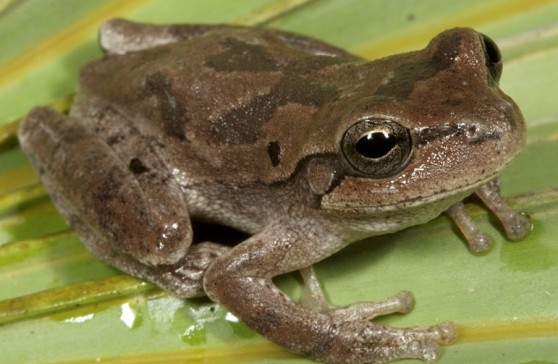While you are staying in one of Archbold’s cottages, was delighted to hear a chorus of frog calls each evening, one of the many special surprises visitors who spend the night on the station have the pleasure to experience. Complied here are WHO’s notes on each species’ individual call, along with photos of each species. Where available, a sound bite of each species’ call is also provided. Simply click on the species’ photo, and the audio recording will open in a pop-up window. Pay attention, and next time you hear a frog call in your backyard, you may be able to identify it!
Special thanks to AmphibiaWeb, which was used to compile all photos and recordings.
Cricket frog (Acris gryllus): “ticking” sound, like tapping 2 pebbles together; always in standing water, often calls during daytime right across the railroad tracks
Oak toad (Anaxyrus quercicus): high-pitched, sharp, ascending whistle; huge evening choruses

Oak toad (Anaxyrus quercicus). Photo by Todd Pierson (2010).
Southern toad (Anaxyrus terrestris): shrill, long, high-pitched screech; rare, usually during rain

Southern toad (Anaxyrus terrestris). Photo by William Flaxington (2016).
Greenhouse frog (Eleutherodactylus planirostris): short, delicate series of notes, insect-like and soft; calls from deck, garden, and palmettos around the cottage

Greenhouse frog (Eleutherodactylus planirostris). Click on photo to hear call. Photo by William Flaxington (2016).
Green treefrog (Hyla cinerea): single, harsh croak, higher pitched and louder than H. squirrela
Pine woods treefrog (Hyla femoralis): low-pitched rattle, like “Morse-code;” forms constant background on rainy-night frog choruses

Pine woods treefrog (Hyla femoralis). Photo by Todd Pierson (2010).
Barking tree frog (Hyla gratiosa): single, spaced “barks” rarely near the cottage but often heard at distance

Barking tree frog (Hyla gratiosa). Photo by Todd Pierson (2010).
Squirrel tree frog (Hyla squirella): single, hoarse, ascending croak, often in short series; calls from trees, in rain

Squirrel tree frog (Hyla squirella). Click on photo to hear call. Photo by William Flaxington (2016).
Little grass frog (Pseudacris ocularis): extremely high-pitched, metallic, cricket-like sound; always calls from grassy areas; very common, but hard to pick out

Little grass frog (Pseudacris ocularis). Photo by Todd Pierson (2010).
Gopher frog (Rana capito): very distinctive; a long, loud “snore;” choruses sometimes in fall, winter rains

Gopher frog (Rana capito). Photo by Todd Pierson (2011).
Common bullfrog (Rana catesbeiana): sonorous “rum, rum, jug-o-rum!”

Common bullfrog (Rana catesbeiana). Click on photo to hear call. Photo by William Flaxington (2013).
Pig frog (Rana grylio): low, hoarse “grunt” given singly or in couplet or triplet; sounds like a pig; calls only when water across the railroad tracks gets high

Pig frog (Rana grylio). Photo by Todd Pierson (2011).
Southern leopard frog (Rana sphenocephala): many variants, but most often sounds like wet rubber gloves being tightly rubbed together; liquid sounds like “k-k-k-ker-joit!” also “t-t-t-tot-tout!”

Southern leopard frog (Rana sphenocephala). Click on photo to hear call. Photo by William Flaxington (2018).
Cuban treefrog (Osteopilus septentrionalis): INVASIVE SPECIES

Cuban treefrog (Osteopilus septentrionalis). Click on photo to hear call. Photo by William Flaxington (2016).
Cane toad (Rhinella marina): INVASIVE SPECIES




Enjoyed reading and listening. Tree frogs in my garden.
LikeLike